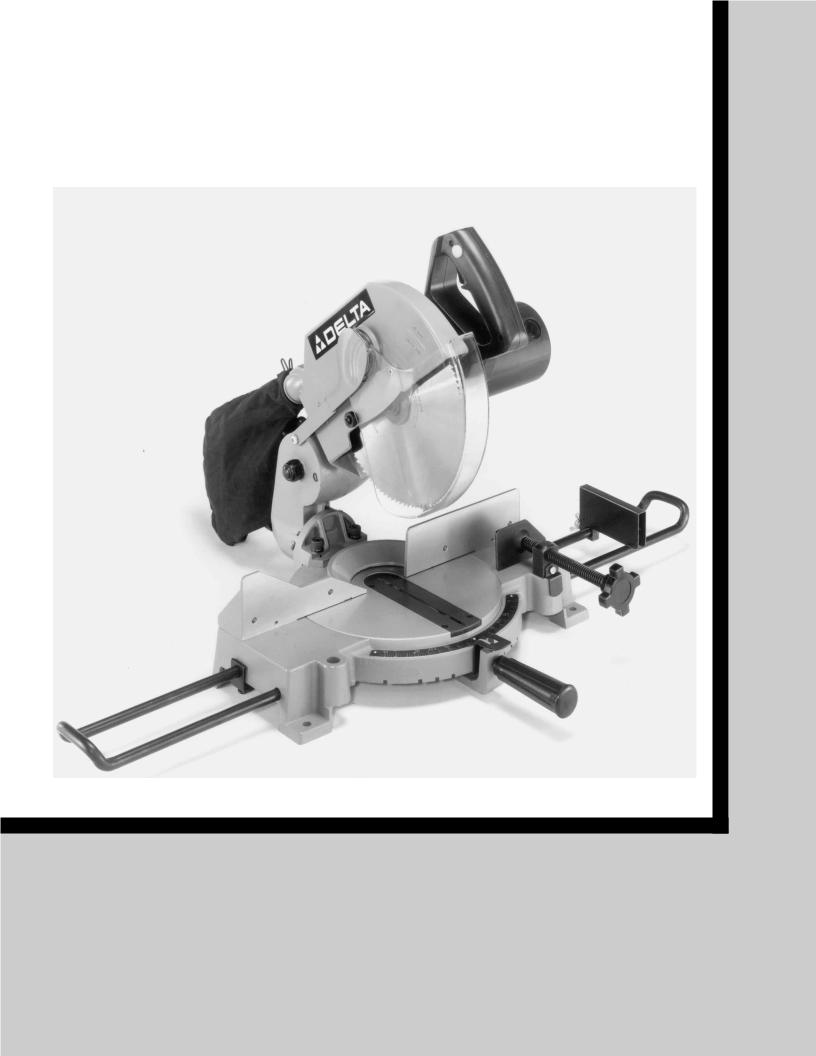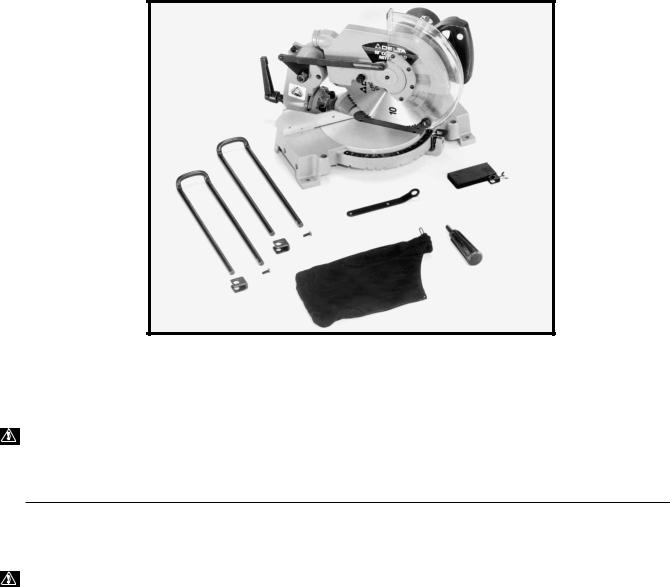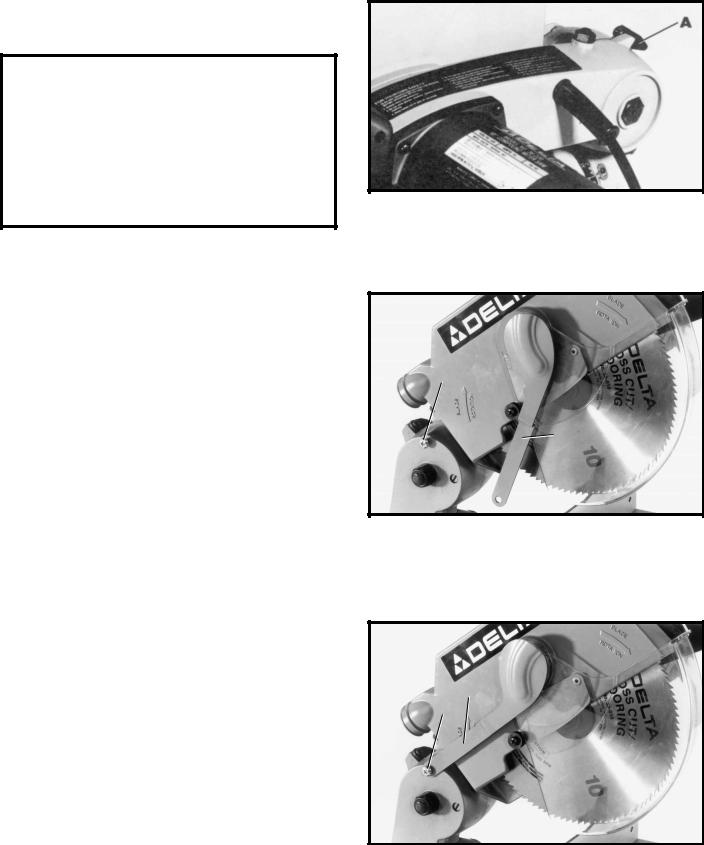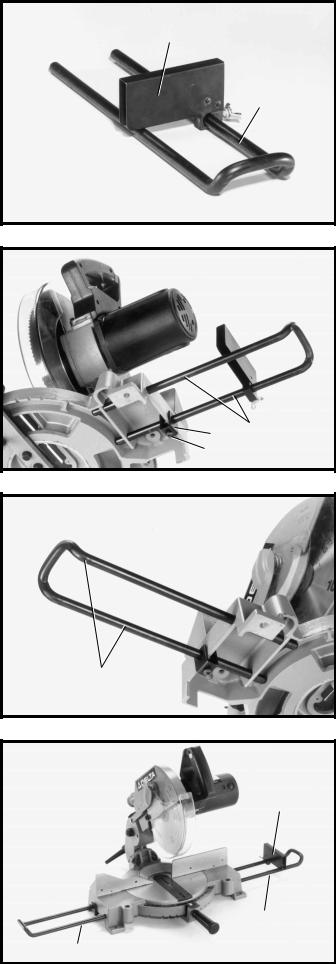Delta 36-220 User Manual

10" Compound Miter Saw
(Model 36-220)
PART NO. 900327 - 01-01-01
Copyright © 2001 Delta Machinery
To learn more about DELTA MACHINERY |
ESPAÑOL: PÁGINA 23 |
visit our website at: www.deltamachinery.com. |
|
|
|
For Parts, Service, Warranty or other Assistance, |
|
please call 1-800-223-7278 (In Canada call 1-800-463-3582).
MANUAL INSTRUCTION

SAFETY RULES
Woodworking can be dangerous if safe and proper operating procedures are not followed. As with all machinery, there are certain hazards involved with the operation of the product. Using the machine with respect and caution will considerably lessen the possibility of personal injury. However, if normal safety precautions are overlooked or ignored, personal injury to the operator may result. Safety equipment such as guards, push sticks, hold-downs, featherboards, goggles, dust masks and hearing protection can reduce your potential for injury. But even the best guard won’t make up for poor judgment, carelessness or inattention. Always use common sense and exercise caution in the workshop. If a procedure feels dangerous, don’t try it. Figure out an alternative procedure that feels safer. REMEMBER: Your personal safety is your responsibility.
This machine was designed for certain applications only. Delta Machinery strongly recommends that this machine not be modified and/or used for any application other than that for which it was designed. If you have any questions relative to a particular application, DO NOT use the machine until you have first contacted Delta to determine if it can or should be performed on the product.
Technical Service Manager
Delta Machinery
4825 Highway 45 North
Jackson, TN 38305
(IN CANADA: 505 SOUTHGATE DRIVE, GUELPH, ONTARIO N1H 6M7)
WARNING: FAILURE TO FOLLOW THESE RULES MAY RESULT IN SERIOUS PERSONAL INJURY
1.FOR YOUR OWN SAFETY, READ INSTRUCTION MANUAL BEFORE OPERATING THE TOOL. Learn the tool’s application and limitations as well as the specific hazards peculiar to it.
2.KEEP GUARDS IN PLACE and in working order.
3.ALWAYS WEAR EYE PROTECTION.
4.REMOVE ADJUSTING KEYS AND WRENCHES. Form habit of checking to see that keys and adjusting wrenches are removed from tool before turning it “on”.
5.KEEP WORK AREA CLEAN. Cluttered areas and benches invite accidents.
6.DON’T USE IN DANGEROUS ENVIRONMENT. Don’t use power tools in damp or wet locations, or expose them to rain. Keep work area well-lighted.
7.KEEP CHILDREN AND VISITORS AWAY. All children and visitors should be kept a safe distance from work area.
8.MAKE WORKSHOP CHILDPROOF – with padlocks, master switches, or by removing starter keys.
9.DON’T FORCE TOOL. It will do the job better and be safer at the rate for which it was designed.
10.USE RIGHT TOOL. Don’t force tool or attachment to do a job for which it was not designed.
11.WEAR PROPER APPAREL. No loose clothing, gloves, neckties, rings, bracelets, or other jewelry to get caught in moving parts. Nonslip footwear is recommended. Wear protective hair covering to contain long hair.
12.ALWAYS USE SAFETY GLASSES. Wear safety glasses. Everyday eyeglasses only have impact resistant lenses; they are not safety glasses. Also use face or dust mask if cutting operation is dusty. These safety glasses must conform to ANSI Z87.1 requirements. Note: Approved glasses have Z87 printed or stamped on them.
13.SECURE WORK. Use clamps or a vise to hold work when practical. It’s safer than using your hand and frees both hands to operate tool.
14.DON’T OVERREACH. Keep proper footing and balance at all times.
15.MAINTAIN TOOLS IN TOP CONDITION. Keep tools sharp and clean for best and safest performance. Follow instructions for lubricating and changing accessories.
16.DISCONNECT TOOLS before servicing and when changing accessories such as blades, bits, cutters, etc.
17.USE RECOMMENDED ACCESSORIES. The use of accessories and attachments not recommended by Delta may cause hazards or risk of injury to persons.
18.REDUCE THE RISK OF UNINTENTIONAL STARTING. Make sure switch is in “OFF” position before plugging in power cord.
19.NEVER STAND ON TOOL. Serious injury could occur if the tool is tipped or if the cutting tool is accidentally contacted.
20.CHECK DAMAGED PARTS. Before further use of the tool, a guard or other part that is damaged should be carefully checked to ensure that it will operate properly and perform its intended function – check for alignment of moving parts, binding of moving parts, breakage of parts, mounting, and any other conditions that may affect its operation. A guard or other part that is damaged should be properly repaired or replaced.
21.DIRECTION OF FEED. Feed work into a blade or cutter against the direction of rotation of the blade or cutter only.
22.NEVER LEAVE TOOL RUNNING UNATTENDED. TURN POWER OFF. Don’t leave tool until it comes to a complete stop.
23.DRUGS, ALCOHOL, MEDICATION. Do not operate tool while under the influence of drugs, alcohol or any medication.
24.MAKE SURE TOOL IS DISCONNECTED FROM POWER SUPPLY while motor is being mounted, connected or re-connected.
25.THE DUST GENERATED by certain woods and wood products can be injurious to your health. Always operate machinery in well ventilated areas and provide for proper dust removal. Use wood dust collection systems whenever possible.
26. WARNING: SOME DUST CREATED BY POWER SANDING, SAWING, GRINDING, DRILLING, AND OTHER CONSTRUCTION ACTIVITIES contains chemicals known to cause cancer, birth defects or other reproductive harm. Some examples of these chemicals are:
WARNING: SOME DUST CREATED BY POWER SANDING, SAWING, GRINDING, DRILLING, AND OTHER CONSTRUCTION ACTIVITIES contains chemicals known to cause cancer, birth defects or other reproductive harm. Some examples of these chemicals are:
·lead from lead-based paints,
·crystalline silica from bricks and cement and other masonry products, and
·arsenic and chromium from chemically-treated lumber.
Your risk from these exposures varies, depending on how often you do this type of work. To reduce your exposure to these chemicals: work in a well ventilated area, and work with approved safety equipment, such as those dust masks that are specially designed to filter out microscopic particles.
SAVE THESE INSTRUCTIONS
2
ADDITIONAL SAFETY RULES FOR COMPOUND MITER SAWS
1.USE ONLY CROSS-CUTTING SAW BLADES. WHEN USING CARBIDE TIPPED BLADES, MAKE SURE THEY HAVE A NEGATIVE HOOK ANGLE. DO NOT USE BLADES WITH DEEP GULLETS AS THEY CAN DEFLECT AND CONTACT GUARD.
2.DO NOT OPERATE the miter saw until it is completely assembled and installed according to the instructions.
3.IF YOU ARE NOT thoroughly familiar with the operation of miter saws, obtain advice from your supervisor, instructor or other qualified person.
4.ALWAYS hold the work firmly against the fence and table. DO NOT perform any operation freehand.
5.KEEP HANDS OUT OF PATH of saw blade. If the workpiece you are cutting would cause your hand to be within hazard zone of the saw blade, the workpiece should be clamped in place before making cut.
6.BE SURE blade is sharp, runs freely and is free of vibration.
7.ALLOW the motor to come up to full speed before starting cut.
8.KEEP motor air slots clean and free of chips.
9.ALWAYS MAKE SURE all clamp handles are tight before cutting, even if the table is positioned in one of the positive stops.
10.BE SURE blade and flanges are clean and that arbor screw is tightened securely.
11.USE only blade flanges specified for your saw.
12.NEVER use blades larger or smaller in diameter than recommended.
13.NEVER apply lubricants to the blade when it is running.
14.ALWAYS check the blade for cracks or damage before operation. Replace cracked or damaged blade immediately.
15.NEVER use blades recommended for operation at less than 5500 RPM.
16.USE the blade guard at all times.
17.ALWAYS keep the lower blade guard in place.
18.NEVER reach around saw blade.
19.MAKE SURE blade is not contacting workpiece before switch is turned on.
20.NEVER lock the switch in the “ON” position.
21.IMPORTANT: After completing cut, release power switch and wait for coasting blade to stop before returning saw to raised position.
22.MAKE SURE blade has come to a complete stop before removing or securing workpiece, changing workpiece angle or changing the angle of the blade.
23.NEVER cut ferrous metals or masonry.
24.NEVER recut small pieces.
25.PROVIDE adequate support to the sides of the saw table for long workpieces.
26.NEVER use the miter saw in an area with flammable liquids or gases.
27.NEVER use solvents to clean plastic parts. Solvents could possibly dissolve or otherwise damage the material. Only a soft damp cloth should be used to clean plastic parts.
28.SHUT OFF power before servicing or adjusting tool.
29.DISCONNECT saw from power source and clean the machine before leaving it.
30.MAKE SURE the work area is cleaned before leaving the machine.
31.SHOULD any part of your miter saw be missing, damaged or fail in any way, or any electrical component fail to perform properly, shut off switch and remove plug from power supply outlet. Replace missing, damaged or failed parts before resuming operation.
32.ADDITIONAL INFORMATION regarding the safe and proper operation of this product is available from the National Safety Council, 1121 Spring Lake Drive, Itasca, IL 60143-3201, in the Accident Prevention Manual for Industrial Operation and also in the Safety Data Sheets provided by the NSC. Please also refer to the American National Standard Institute ANSI 01.1 Safety Requirements for Woodworking Machinery and the U.S. Department of Labor OSHA 1910.213 Regulations.
3

CONNECTING COMPOUND MITER SAW
TO POWER SOURCE
Your new Compound Miter Saw is DOUBLE INSULATED to give you added safety. As a result, this saw is equipped with a two-prong plug which permits you to use any conventional 120 Volt electrical outlet without concern for maintaining a ground connection.
Before connecting the motor to the power source make sure that the electric current is of the same characteristics as the motor - 120 Volts. All line connections should make good contact. Running on low voltage will damage the motor.
CAUTION: WHEN SERVICING DOUBLE INSULATED TOOLS, USE ONLY IDENTICAL REPLACEMENT PARTS. REPLACE OR REPAIR DAMAGED CORDS IMMEDIATELY.
MOTOR SPECIFICATIONS
Your miter saw is wired for 110-120 volt, 60 HZ alternating current. Before connecting the miter saw to the power source, make sure the switch is in the “OFF” position. The motor provides a no-load speed of 5200 RPM.
REPLACEMENT PARTS
When servicing, use only identical replacement parts.
POLARIZED PLUGS: To reduce the risk of electric shock, this equipment has a polarized plug (one blade is wider than the other). This plug will fit in a polarized outlet only one way. If the plug does not fit fully in the outlet, reverse the plug. If it still does not fit, contact a qualified electrician to install the proper outlet. Do not change the plug in any way.
EXTENSION CORDS
Use proper extension cords. Make sure your extension cord is in good condition and be sure to use one heavy enough to carry the current of the saw. An undersized cord will cause a drop in line voltage resulting in loss of power and overheating. Fig. D, shows the correct size to use depending on cord length. If in doubt, use the next heavier gage. The smaller the gage number, the heavier the cord.
MINIMUM GAUGE EXTENSION CORD |
|
MINIMUM GAUGE EXTENSION CORD |
||||||
RECOMMENDED SIZES FOR USE WITH STATIONARY ELECTRIC TOOLS |
|
RECOMMENDED SIZES FOR USE WITH STATIONARY ELECTRIC TOOLS |
||||||
Ampere |
Volts |
Total Length of |
Gauge of |
|
Ampere |
Volts |
Total Length of |
Gauge of |
Rating |
|
Cord in Feet |
Extension Cord |
|
Rating |
|
Cord in Feet |
Extension Cord |
0-6 |
120 |
up to 25 |
18 AWG |
|
0-6 |
240 |
up to 50 |
18 AWG |
0-6 |
120 |
25-50 |
16 AWG |
|
0-6 |
240 |
50-100 |
16 AWG |
0-6 |
120 |
50-100 |
16 AWG |
|
0-6 |
240 |
100-200 |
16 AWG |
0-6 |
120 |
100-150 |
14 AWG |
|
0-6 |
240 |
200-300 |
14 AWG |
6-10 |
120 |
up to 25 |
18 AWG |
|
6-10 |
240 |
up to 50 |
18 AWG |
6-10 |
120 |
25-50 |
16 AWG |
|
6-10 |
240 |
50-100 |
16 AWG |
6-10 |
120 |
50-100 |
14 AWG |
|
6-10 |
240 |
100-200 |
14 AWG |
6-10 |
120 |
100-150 |
12 AWG |
|
6-10 |
240 |
200-300 |
12 AWG |
10-12 |
120 |
up to 25 |
16 AWG |
|
10-12 |
240 |
up to 50 |
16 AWG |
10-12 |
120 |
25-50 |
16 AWG |
|
10-12 |
240 |
50-100 |
16 AWG |
10-12 |
120 |
50-100 |
14 AWG |
|
10-12 |
240 |
100-200 |
14 AWG |
10-12 |
120 |
100-150 |
12 AWG |
|
10-12 |
240 |
200-300 |
12 AWG |
12-16 |
120 |
up to 25 |
14 AWG |
|
12-16 |
240 |
up to 50 |
14 AWG |
12-16 |
120 |
25-50 |
12 AWG |
|
12-16 |
240 |
50-100 |
12 AWG |
12-16 |
120 |
GREATER THAN 50 FEET NOT RECOMMENDED |
|
12-16 |
240 |
GREATER THAN 100 FEET NOT RECOMMENDED |
||
|
|
|
|
|
|
|
|
|
Fig. D
4

OPERATING INSTRUCTIONS
FOREWORD
Delta Model 36-220 is a 10" Compound Miter Saw designed to cut wood. It can crosscut up to 2-3/4" x 5-1/8", miter at 45° both left and right 2-3/4" x 3-1/2", bevel at 45° left 1-3/4" x 5-1/8", and compound 45° x 45°, 1-3/4" x 3-1/2". It has miter stops at 0°, 15°, 22.5°, 30°, and 45° degrees both left and right, and positive bevel stops at 0° and 45° left. It also includes the following features; Double Insulated construction for operator safety, D-handle design with trigger switch for positive control, lock-out button to prevent accidental starts, Electric brake automatically stops blade in seconds, Automatic retracting see-thru blade guard, Built-in arbor lock for easy single wrench blade changes, Dust bag, Work supports, Extra-wide fence and Replaceable cut-thru table insert for optimum chipbreaking.
UNPACKING
Remove the miter saw and all loose items from the carton. IMPORTANT: DO NOT LIFT THE MITER SAW BY THE
SWITCH HANDLE OR TABLE CONTROL HANDLE AS THIS MAY CAUSE MISALIGNMENT. ALWAYS LIFT THE MACHINE BY THE BASE.
Fig. 1
WARNING: FOR YOUR OWN SAFETY, DO NOT CONNECT THE MITER SAW TO THE POWER SOURCE
UNTIL THE MACHINE IS COMPLETELY ASSEMBLED AND YOU HAVE READ AND UNDERSTOOD THE
ENTIRE OWNER’S MANUAL.
ASSEMBLY INSTRUCTIONS
WARNING: MAKE CERTAIN THE POWER CORD IS DISCONNECTED FROM THE POWER SOURCE
DURING THE COMPLETE ASSEMBLY PROCEDURE.
5

ASSEMBLING LOWER BLADE GUARD LINK
 WARNING: DO NOT ATTEMPT TO OPERATE THE SAW WITHOUT THE BLADE GUARD IN PLACE, AS PERSONAL INJURY OR PRODUCT DAMAGE CAN OCCUR. THE BLADE GUARD ASSEMBLY SERVES AS A RETENTION MEANS FOR THE SAW ARBOR. ANY PRODUCT ADJUSTMENTS OR SERVICING, NOT COVERED BY THIS INSTRUCTION MANUAL, SHOULD BE UNDERTAKEN ONLY BY AN AUTHORIZED DELTA SERVICE REPRESENTATIVE.
WARNING: DO NOT ATTEMPT TO OPERATE THE SAW WITHOUT THE BLADE GUARD IN PLACE, AS PERSONAL INJURY OR PRODUCT DAMAGE CAN OCCUR. THE BLADE GUARD ASSEMBLY SERVES AS A RETENTION MEANS FOR THE SAW ARBOR. ANY PRODUCT ADJUSTMENTS OR SERVICING, NOT COVERED BY THIS INSTRUCTION MANUAL, SHOULD BE UNDERTAKEN ONLY BY AN AUTHORIZED DELTA SERVICE REPRESENTATIVE.
1.Push down on the cuttinghead handle slightly and rotate latch (A) Fig. 2, to the other side.
2.The cuttinghead will then move to the up position and the lower blade guard link (B) Fig. 3, will hang freely in the down position, as shown.
3.Remove special screw (C) Fig. 3, from the pivot bracket.
4. Insert special screw (C) Fig. 4, into hole in end of lower blade guard link (B) and reassemble special screw
(C) into hole in pivot bracket, as shown.
Fig. 2
C
B
Fig. 3
B
C
Fig. 4
6

ASSEMBLING STOCK STOP AND TABLE EXTENSIONS
1. Decide on which side of the saw table you want the stock stop (A) Fig. 5, to be, and assemble stock stop (A) onto table extension (B), as shown. NOTE: The most commonly used position of the stock stop will be on the right hand table extension, as shown.
2. Insert ends of table extension (B) Fig. 6, into the four holes on end of saw base and into the two holes of lock bracket (C), as shown. Tighten screw (D) to hold table extension in place.
3. Assemble left hand table extension (E) Fig. 7, in the same manner.
4. Fig. 8, illustrates both the right and left hand table extensions (B) and (E) assembled to the saw and the stock stop (A) assembled to the right hand table extension.
A
B
Fig. 5
C B
D
Fig. 6
E
Fig. 7
A
B
E
Fig. 8
7
